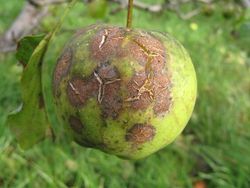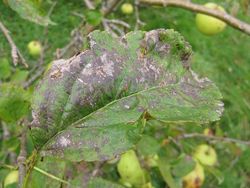 How are your apples? Mine look absolutely ghastly. Our unnamed 25 year-old variety that ripens round now is, pretty much, one big scab. OK, so the fruit is still broadly edible, but some of the scab is so bad that it's cracked, and those apples will have to be used asap before disease creeps in.
How are your apples? Mine look absolutely ghastly. Our unnamed 25 year-old variety that ripens round now is, pretty much, one big scab. OK, so the fruit is still broadly edible, but some of the scab is so bad that it's cracked, and those apples will have to be used asap before disease creeps in.
All parts of a tree can be affected, and scab also causes early leaf fall and thus weakens the tree if it continues for several seasons.
Not every apple gets scab. Our Egremont Russet has escaped, faithfully living up to its reputation as one of the numerous varieties that are extremely scab resistant. So what happened to the anonymous variety this year? There's often a bit of scab, but on nothing like the scale we're seeing now.
What is Apple Scab?
Apple scab is a fungus (Venturia inaequalis) which overwinters on fallen leaves. You have to admire Nature. Maturity of spores, rather magically, coincides with the development of the tree, and their release begins with bud-break, when the leaves first emerge (a time also known as "green-tip"). By the time the blossom is over, most spores have matured, spurred on by periods of weather most conducive to tree growth (when, presumably, they're somehow alerted to the presence of fresh "flesh").
 The number of spores released is, as you can imagine, directly related to the number of infected leaves left over from the previous season. A 1-3% increase in infected leaves on the ground is likely to result, the following spring, in a 10% increase of spores released at green-tip; a 5% increase leads to a ten-fold increase in spores. (Source: Apple Scab Disease Management video from MSU).
The number of spores released is, as you can imagine, directly related to the number of infected leaves left over from the previous season. A 1-3% increase in infected leaves on the ground is likely to result, the following spring, in a 10% increase of spores released at green-tip; a 5% increase leads to a ten-fold increase in spores. (Source: Apple Scab Disease Management video from MSU).
Mature spores are released in wet weather, about half an hour after rain begins (fascinatingly, if it rains at night, spores don't usually spurt forth until daybreak - fungus afraid of the dark?). They're blown by wind onto fruit and leaves, which need to be wet for them to germinate. They will then infect the apple if conditions are favourable. For example, if leaves and fruit stay wet for 23 hours at an average 5.5 degrees Centigrade (42F), or 9 hours at 16-24 degrees C (61-75F), then lesions will appear in approx 3 or 2 weeks respectively.
Spores from these new lesions are dispersed by rain throughout the season and - wouldn't you know it? - these these lesions release even more spores than are coming from the lesions on leaves on the ground. So infection continues, although leaves are completely resistant once they're full grown, and only succumb again once their cuticles begin to crack. Fruit also becomes more resistant, though late scab infection can develop in stored fruit.
Why this year?
April and May were warmer than average for most in the UK, and in April and May we had plenty of rain in the south, so it's not surprising that fungus flourished.
But not without a little help, you're no doubt thinking.
And you'd be right - I never clear up leaves. Combine this with the weather and the result are obvious to all. But enough of my sluttish ways. This year every single leaf is coming out from under that tree. Yes, there are sprays that can be employed at strategic moments in spring, but let's see if a little garden hygiene won't go a long way.
Annoyingly, as the tree tends to bear biennially, if it does work I won't enjoy the fruits of my labour until 2016.
(Incidentally, if you'd like more science, Cornell University has a useful Apple Scab factsheet. And so does the Horticultural Development Company.)


Recent Comments